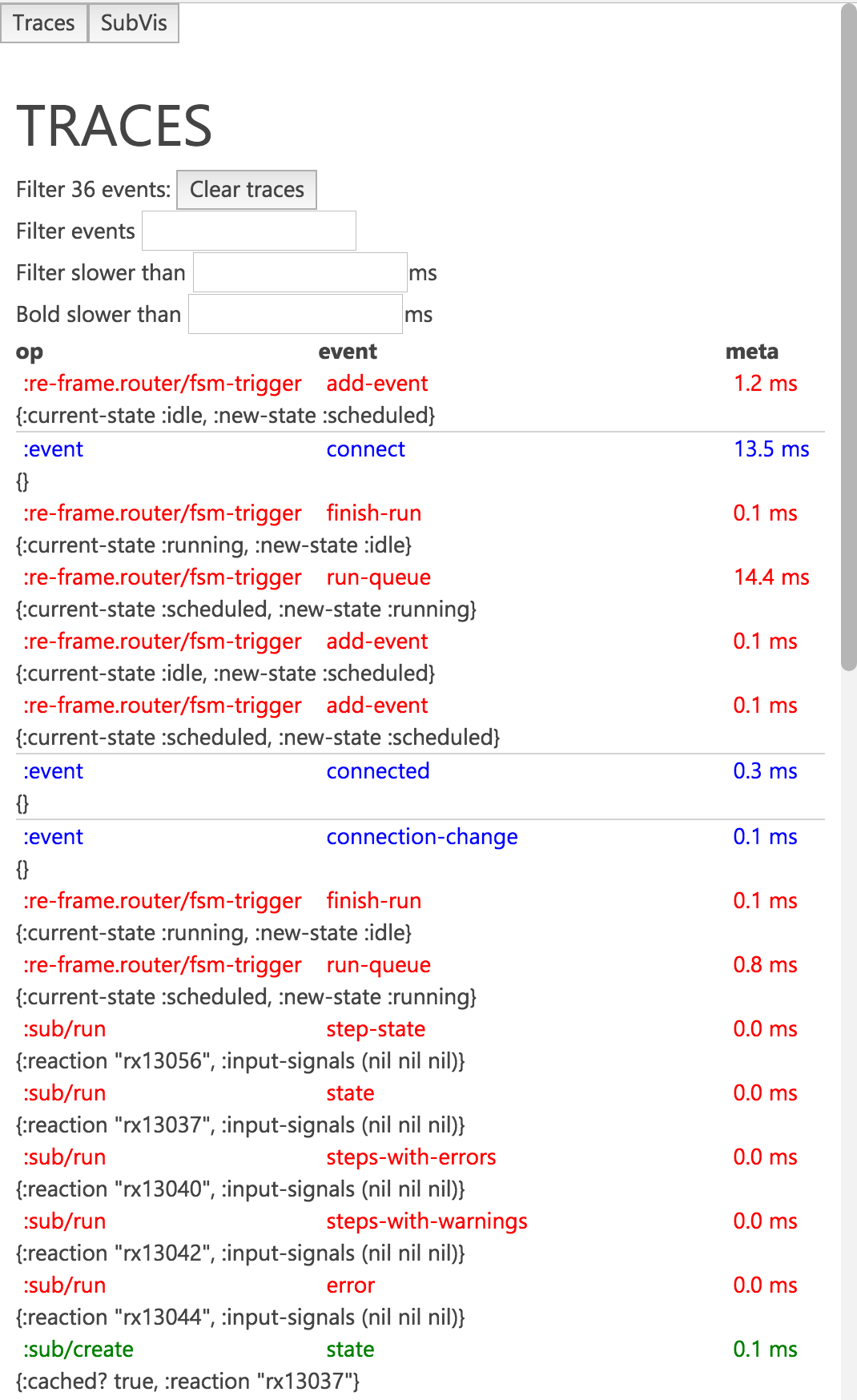re-frame-trace
A trace panel for re-frame.
Motivation
re-frame provides a data driven architecture, but we need to be able to inspect it. re-frame-trace takes inspiration from redux-devtools, and provides several ways to visualise the structure and state of your re-frame application.

Installation
If you are using leiningen, modify project.clj in the following ways. When puzzling over the various possible leiningen configurations, it's often helpful to look at a sample project.clj.
-
Add re-frame-trace as a dev dependency by placing
[day8.re-frame/trace "0.1.0"]within:profiles :dev :dependencies. For example::profiles {:dev {:dependencies [[some-other-package "0.0.0"] [day8.re-frame/trace "0.1.0"]] }} -
Locate the
:compilermap under:devand add::closure-defines {"re_frame.trace.trace_enabled_QMARK_" true}:preloads [day8.re-frame.trace.preload]
For example:
{:builds [{:id "dev" :source-paths ["src" "dev"] :compiler {... :closure-defines {"re_frame.trace.trace_enabled_QMARK_" true} :preloads [day8.re-frame.trace.preload]}}]}
Usage
-
Start up your application.
-
Once it is loaded, focus the document window and press
ctrl-hto slide open the trace panel and enable tracing. -
When the panel is closed, tracing is disabled.
How does it work?
re-frame has instrumentation to collect traces throughout various important points in the lifecycle of a re-frame app. re-frame-trace is a consumer of these traces, and provides visualisations of the traces. These traces have a well-defined structure, and will eventually be standardised, allowing other developers to create their own tooling to work against the traces. Currently, re-frame's tracing and re-frame-trace are in alpha and are subject to change at any time.
By default, re-frame tracing is compiled out, so it won't impose a performance cost in production. The trade-off here is that you need to explicitly enable it in development.
The preloads option (:preloads [day8.re-frame.trace.preload]) has to be set in order to automatically monkeypatch Reagent to add appropriate lifecycle hooks. Yes this is gross, and yes we will try and make a PR to reagent to add proper hooks, once we know exactly what we need. The preload namespace also injects a div containing the devtools panel into the DOM.
Development
Setting up re-frame-trace for development
You need both the re-frame-trace project and a test project to develop it against. For example, you can use the todo-mvc project.
-
Clone
re-frame-traceto your machine:git clone git@github.com:Day8/re-frame-trace.git -
Go into the root folder of the test project you're using to develop re-frame-trace with.
cd /your/project/folder -
Add re-frame-trace into this test project using the instructions above.
-
Still in the test project, create a folder called
checkouts, then enter the folder:mkdir checkouts cd checkouts -
Create a relative symlink from your local re-frame-trace project in the checkouts folder. For example:
ln -s ../relative/path/to/your/local/re-frame-trace re-frame-trace -
If you're using figwheel in the test project, you need to add the checkouts folder (
checkouts/re-frame-trace/src) to:cljsbuild :source-pathsin theproject.cljfile. If you're having trouble locating the right place to put this, it might help to look to a sample project.clj for inspiration. For example::cljsbuild {:builds {:client {:source-paths ["checkouts/re-frame-trace/src"]}}} -
Now run your test project however you usually run it, and re-frame-trace should be in there. \o/